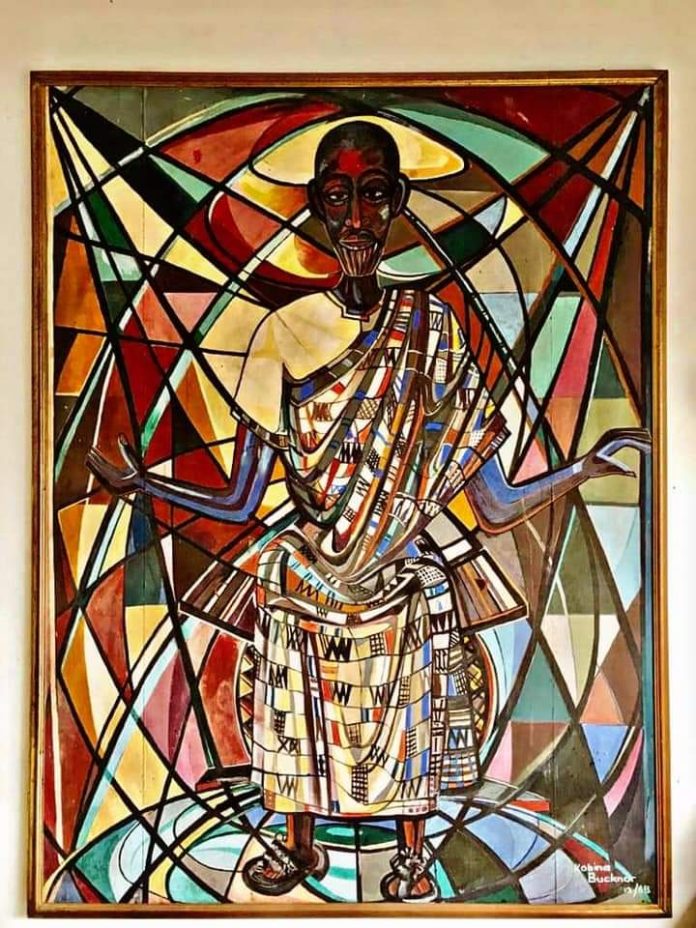This painting by one of Ghana’s famous modernist cubist painters Kobina Bucknor (1925 -1975) demonstrates one of the most controversial of all types of imaginative painting -the art of Incarnation. This is the art of giving physical form to the spiritual.
In this case, the Highest of all Spirits, the Supreme Deity called Oyankopon (Creator of all things) in Akan and whom the Abyssinians refer to as Yenegešitati niguši ina yegētochi gēta (Kings of kings and Lord of Lords) is the subject of incarnation from the spiritual to the physical.
Almost a forbidden act in some major religions, Kobina Bucknor ‘incarnates’ the Supreme God unto canvas as an elderly Akan gentleman I as a human can reverently refer to as ‘Agya’ meaning Father or Uncle in the Akan social setting.
The colorful cubist painting in acrylic polymers is displayed on a wall in Christ the King Church – the Catholic parish in Accra Ghana. It was commissioned as an alter piece 53 years ago as part of a sets of 14 smaller paintings depicting the Stations of the Cross, a Catholic Easter ritual. Years later, a successive parish council preferred a large wooden crucifix in its place and had the painting moved to the veneration corner of the church where it remains today.
Depicted in a semi-realistic style reminiscent of Aksumite art, Agya is a slender figured dignified septuagenarian with a peaceful, attentive elongated face whispering a non-verbal sermon through His gentle expressionless eyes.
The old man garbed in traditional royal multi-partnered Kente cloth thrown over a simple short sleeve silk tunic, sits in a transcendental state on a traditional Sacred Akan stool -a symbol of rulership and authority.
The background of the painting is painted in cubist style. All around Him are vertically oriented lines in fierce parabolic movements which represent the powerful, spiritual, cosmic forces which exist between the spiritual and physical realms.
This gives a mystic setting to the incarnate of the Spirit of the Most High Onyankopon seated in the heavenly realms with his feet in traditional Ahenba (royal sandals) upon the circle of the earth over which He wields ultimate power.
Instead of a royal crown on his head, a brightly colored halo signifying Him as the source of illumination of soul floats above His head. The Supreme Deity needs no crown for he was crowned by no one.
Curiously, for one who is King of Kings and Lords of Lords, in the Akan tradition, His depiction is devoid of royal regalia, umbrella or ornamentation of human kings. No signs of earthly wealth, no beads to signify status, necklaces, and amulets for protection, no jewelry, bracelets, charms, or gold bangles on his arms.
Again, he holds no scepter or staff. In a peculiar symbolic gesture, His right palm faces upwards as it receives from Heaven above and His left palm faces downwards giving to the Earth below – the sign of Divine connection between the two realms only possible through Him.
Kobina Bucknor ’s African Christ ; Agya, the Father, God incarnate, is represented in the simplicity of appearance without all pomp, glory best tells us something about the deep nature of the Supreme Godhead -His approachability- an attribute of Christ.
“Come to me, all you who are weary and burdened, and I will give you rest. – Matthew 11:28
Arc. Kojo Derban 2/10/21


